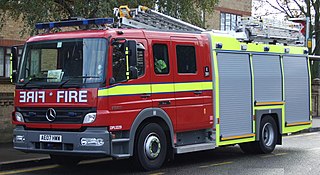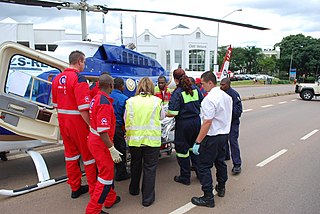
Emergency medical services (EMS), also known as ambulance services or paramedic services, are emergency services that provide urgent pre-hospital treatment and stabilisation for serious illness and injuries and transport to definitive care. They may also be known as a first aid squad, FAST squad, emergency squad, ambulance squad, ambulance corps, life squad or by other initialisms such as EMAS or EMARS.

A fire engine, also known in some places as a fire truck or fire lorry, is a road vehicle that functions as a firefighting apparatus. The primary purposes of a fire engine include transporting firefighters to an incident as well as carrying equipment for firefighting and technical rescue operations. Some fire engines have specialised functions, such as hazardous materials mitigation, urban search and rescue, and aircraft rescue and firefighting.

The Los Angeles Fire Department provides emergency medical services, fire cause determination, fire prevention, fire suppression, hazardous materials mitigation, and rescue services to the city of Los Angeles, California, United States. The LAFD is responsible for approximately 4 million people who live in the agency's 471 square miles (1,220 km2) jurisdiction.

A certified first responder is a person who has completed a course and received certification in providing pre-hospital care for medical emergencies. Certified individuals should have received much more instruction than someone who is trained in basic first aid and cardiopulmonary resuscitation (CPR) but they are not necessarily a substitute for more advanced emergency medical care rendered by emergency medical technicians (EMTs) and paramedics. First responders typically provide advanced first aid level care, CPR, and automated external defibrillator (AED) usage. The term "certified first responder" is not to be confused with "first responder", which is a generic term referring to the first medically trained responder to arrive on scene and medically trained telecommunication operators who provide pre-arrival medical instructions as trained Emergency Medical Dispatchers (EMD). Many police officers and firefighters are required to receive training as certified first responders. Advanced medical care is typically provided by EMS, although some police officers and firefighters also train to become emergency medical technicians or paramedics.
The Seattle & King County Emergency Medical Services System is a fire-based two-tier response system providing prehospital basic and advanced life support services.

A water tender is a type of firefighting apparatus that specialises in the transport of water from a water source to a fire scene. Water tenders are capable of drafting water from a stream, lake or hydrant.

Advanced life support (ALS) is a set of life-saving protocols and skills that extend basic life support to further support the circulation and provide an open airway and adequate ventilation (breathing).

Palm Beach County Fire Rescue is one of the largest fire departments in the state of Florida. Palm Beach County Fire Rescue provides fire protection, emergency medical services, ALS transport, technical rescue, hazardous materials mitigation, Aircraft rescue and firefighting, Fire investigation, and 911 Dispatching for unincorporated parts of Palm Beach County, Florida and 19 cities under contract.

The Seattle Fire Department provides fire protection and emergency medical services to the city of Seattle, Washington, United States. The department is responsible for an area of 142.5 square miles (369 km2), including 193 miles (311 km) of waterfront, with a population of 713,700.

A wildland fire engine is a fire engine specifically designed to assist in fighting wildfires by transporting firefighters to the scene and providing them with access to the fire, along with water or other equipment. Most commonly used by the United States Forest Service, there are multiple types of wildfire apparatus which are used in different scenarios. According to the National Fire Protection Association, if the apparatus will be used primarily for outdoor and wildland responses, then it is to be considered a wildland fire apparatus and must conform to NFPA 1906.

The Cronulla District LifeSaver Rescue Service works with the Water Police, NSW Police, NSW Maritime, Coast Guard, PolAir Helicopters, Westpac Life Saver Rescue Helicopters, Bate Bay Surf Life Saving Clubs as well as clubs in the Royal National Park, and CareFlight helicopters in providing rescue and emergency medical care to the people on Sydney's waterways.

The Gloucestershire Fire and Rescue Service is the statutory emergency fire and rescue service for the non-metropolitan county of Gloucestershire, England. The service is run by Gloucestershire County Council. The service does not cover the unitary authority of South Gloucestershire which is covered by Avon Fire and Rescue Service.

Louisville Metro Emergency Medical Services is the primary provider of pre-hospital life support and emergency care within Louisville-Jefferson County, Kentucky. LMEMS is a governmental department that averages 125,000 calls for service, both emergency and non-emergency, each year.

Hampshire Fire and Rescue Service (HFRS) is the statutory fire and rescue service for the county of Hampshire, on the south coast of England. The service's chief fire officer is Neil Odin.

Emergency medical services in South Africa are a public/private system aimed at the provision of emergency ambulance service, including emergency care and transportation to hospital.
The Albany Fire Department provides fire protection and emergency medical services to the city of Albany, New York. The Department is split up into four different shifts, with each shift made up of 16 companies, which are staffed by 60 members on each shift.

The New Lenox Fire District provides fire protection, emergency medical services, and specialized rescue to 45,000 residents across 36 square miles.

Ukiah Ambulance is now Medstar Ambulance of Mendocino County Inc., a private non-profit ground transport ambulance provider serving central and southern Mendocino County. It is the longest continuously running ambulance service in Mendocino County history. Ukiah Ambulance also developed the first air rescue service in Mendocino County, called FlightCare, which operated for ten years out of the Ukiah Municipal Airport.

The Santa Barbara County Fire Department (SBCFD) provides fire protection and emergency response services for the unincorporated areas of Santa Barbara County, California, and for multiple cities within the county. Together, these areas compose the Santa Barbara County Fire Protection District.
Emergency medical services in Russia is a type of medical assistance provided to citizens in cases of accident, illnesses, injuries, poisonings, and other conditions requiring urgent medical intervention. These services are typically provided by a city or regional government, public emergency hospital, or the Disaster Medical Service. The emergency number for dialing an ambulance in Russia is 03 or the generic European 112.
















